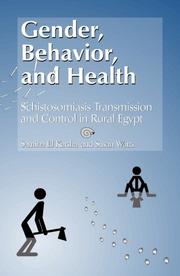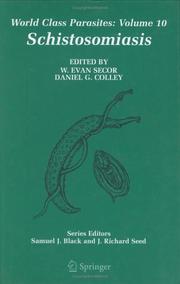| Listing 1 - 10 of 19 | << page >> |
Sort by
|
Book
ISBN: 9535167227 9533078529 Year: 2012 Publisher: IntechOpen
Abstract | Keywords | Export | Availability | Bookmark
 Loading...
Loading...Choose an application
- Reference Manager
- EndNote
- RefWorks (Direct export to RefWorks)
In the wake of the invitation by InTech, this book was written by a number of prominent researchers in the field. It is set to present a compendium of all necessary and up-to-date data to all who are interested. Schistosomiasis or blood fluke disease, also known as Bilharziasis, is a parasitic disease caused by helminths from a genus of trematodes entitled Schistosoma. It is a snail-borne trematode infection. The disease is among the Neglected Tropical Diseases, catalogued by the Global Plan to combat Neglected Tropical Diseases, 2008-2015 and is considered by the World Health Organization (WHO) to be the second most socioeconomically devastating parasitic disease, next to malaria. WHO demonstrates that schistosomiasis affects at least 200 million people worldwide, more than 700 million people live in endemic areas, and more than 200.000 deaths are reported annually. It leads to the loss of about 4.5 million disability-adjusted life years (DALYs).
Schistosomiasis. --- Bilharziasis --- Bilharziosis --- Katayama disease --- Snail fever --- Distomatosis --- Infectious & contagious diseases

ISBN: 1281866040 9786611866044 1848161514 9781848161511 9781860941467 186094146X 9781281866042 6611866043 Year: 2001 Publisher: London River Edge, NJ Imperial College Press World Scientific Pub. Co.
Abstract | Keywords | Export | Availability | Bookmark
 Loading...
Loading...Choose an application
- Reference Manager
- EndNote
- RefWorks (Direct export to RefWorks)
This volume brings together updated fundamental knowledge of the schistosomes, their biology and epidemiology, the mechanism of disease and a full description of the pathological sequelae and clinical syndromes in humans. It concludes with chapters on diagnosis and treatment prospects of vaccine development and the most significant controversies regarding immunology and epidemiology.
Contents:
- Schistosomiasis: Setting the Stage (A AF Mahmoud)
- The Schistosomes and Their Intermediate Hosts (R F Sturrock)
- The Structure and Expression of the Schist
Schistosomiasis. --- Distomatosis. --- Distomiasis --- Trematode infections --- Helminthiasis --- Bilharziasis --- Bilharziosis --- Katayama disease --- Snail fever --- Distomatosis
Book
ISBN: 1803558563 Year: 2022 Publisher: London : IntechOpen,
Abstract | Keywords | Export | Availability | Bookmark
 Loading...
Loading...Choose an application
- Reference Manager
- EndNote
- RefWorks (Direct export to RefWorks)
Although there are thousands of parasites all over the world, Schistosoma spp. are unique in terms of their morphology. Although they have separate bodies as "male" and "female," they live in such a way that the female resides within the male. Schistosomaspp., classified in the family of trematodes, has about twenty members, five of which cause a disease called schistosomiasis (or bilharzia) in humans. This disease causes a variety of symptoms, ranging from simple skin lesions to a dramatic clinical scenario of bladder carcinoma. Although there are many different diagnostic and therapeutic methods, schistosomiasis is still an important threat to humans and a significant challenge for healthcare professionals. This book discusses the morphology, geographic distribution, and evolution of Schistosoma spp ., as well as the diagnosis, treatment, and prevention of schistosomiasis.
Schistosoma. --- Schistosomiasis. --- Bilharziasis --- Bilharziosis --- Katayama disease --- Snail fever --- Distomatosis --- Bilharzia --- Schistosomum --- Schistosomatidae
Book
Year: 1957 Publisher: Bruxelles Académie royale des sciences coloniales
Abstract | Keywords | Export | Availability | Bookmark
 Loading...
Loading...Choose an application
- Reference Manager
- EndNote
- RefWorks (Direct export to RefWorks)
Geneeskunde en aanverwante wetenschappen --- Médecine et sciences connexes --- Sciences appliquées --- Toegepaste wetenschappen --- Bilharzioses --- Bilharziosis --- 616
Multi
ISBN: 2867810604 Year: 1987 Publisher: Bordeaux Université de Bordeaux
Abstract | Keywords | Export | Availability | Bookmark
 Loading...
Loading...Choose an application
- Reference Manager
- EndNote
- RefWorks (Direct export to RefWorks)
Schistosomiasis --- Epidemiology. --- Schistosomiasis. --- -Bilharziasis --- Bilharziosis --- Katayama disease --- Snail fever --- Distomatosis --- Katayama Fever --- Bilharziasis --- Bilharziases --- Fever, Katayama --- Schistosomiases --- Epidemiology --- -Epidemiology --- -Katayama Fever --- Schistoma Infection --- Infection, Schistoma --- Infections, Schistoma --- Schistoma Infections

ISBN: 0748400265 0203481445 9780203481448 0203789687 9780203789681 1482295180 9781482295184 Year: 1994 Publisher: London Taylor & Francis
Abstract | Keywords | Export | Availability | Bookmark
 Loading...
Loading...Choose an application
- Reference Manager
- EndNote
- RefWorks (Direct export to RefWorks)
Freshwater snails --- Snails as carriers of disease --- Schistosomiasis --- Transmission --- Snails. --- Trematoda. --- Trematode Infections. --- Bilharziasis --- Bilharziosis --- Katayama disease --- Snail fever --- Gasteropoda as carriers of disease --- Gastropoda as carriers of disease --- Distomatosis --- Mollusks as carriers of disease --- Freshwater invertebrates --- Snails

ISBN: 1617970247 1936190168 1417522895 9781417522897 9774247280 9789774247286 9781617970245 9781936190164 Year: 2002 Publisher: Cairo ; New York : American University in Cairo Press,
Abstract | Keywords | Export | Availability | Bookmark
 Loading...
Loading...Choose an application
- Reference Manager
- EndNote
- RefWorks (Direct export to RefWorks)
An estimated 200 million people in the world suffer from schistosomiasis and according to the World Health Organization it ranks second behind malaria in terms of socioeconomic and public health importance in tropical and subtropical areas. This is a study of the disease in rural Egypt.
Rural health --- Schistosomiasis --- Women --- Human females --- Wimmin --- Woman --- Womon --- Womyn --- Females --- Human beings --- Femininity --- Bilharziasis --- Bilharziosis --- Katayama disease --- Snail fever --- Distomatosis --- Hygiene, Rural --- Rural public health --- Environmental health --- Health --- Public health --- Medicine, Rural --- Health and hygiene

ISBN: 1280189894 9786610189892 0387233628 038723277X 1441935967 Year: 2005 Volume: 10 Publisher: New York, NY : Springer,
Abstract | Keywords | Export | Availability | Bookmark
 Loading...
Loading...Choose an application
- Reference Manager
- EndNote
- RefWorks (Direct export to RefWorks)
The goal of Schistosomiasis is to provide the reader with insights into the active research and programs currently related to schistosomiasis, and to use these insights as a way to project forward into the next 10-15 years of work on this disease, spanning the spectrum from research to public health interventions. A secondary goal of this volume is to initiate conversations among those working across the research-to-control spectrum on schistosomiasis about the future of their field, and by doing so lead to constructive efforts to identify and address the most critical questions and challenges related to schistosomiasis. The book covers four main areas: schistosome phylogenetics, gene expression, and the overall genome, including information on exciting new tools for addressing questions that have long been inaccessible to schistosomologists; the host-schistosome interaction at the larval to adult worm interface and addresses aspects important for vaccine development as well as how differential gene expression as detected by DNA microarrays may be utilized to develop tools for detection and control of infection or pathology; the development of the host immune response to eggs, granuloma formation and factors affecting the development and regulation of immunopathology; and the public health concerns associated with schistosomiasis, including morbidity control, host genetics, treatment and proposals for improved partnerships. The volume concludes with a chapter addressing the schisms that sometimes exist along the spectrum from basic research programs to the implementation of control schemes, and a proposal to make these differences benefit patients and researchers rather than succumb to base temptations to compete for resources to no one’s benefit. Like many of the diseases featured in the World Class Parasites series, the prospects for dramatic advances in schistosomiasis coincide with a seemingly shrinking pool of both human and material resources. The most meaningful progress will occur as the laboratory better understands the needs in the field and the field better understands the capabilities of the laboratory.
Schistosomiasis. --- Distomatosis. --- Distomiasis --- Trematode infections --- Helminthiasis --- Bilharziasis --- Bilharziosis --- Katayama disease --- Snail fever --- Distomatosis --- Morphology (Animals). --- Emerging infectious diseases. --- Animal Anatomy / Morphology / Histology. --- Infectious Diseases. --- Emerging infections --- New infectious diseases --- Re-emerging infectious diseases --- Reemerging infectious diseases --- Communicable diseases --- Animal morphology --- Animals --- Body form in animals --- Zoology --- Morphology --- Animal anatomy. --- Infectious diseases. --- Animal anatomy --- Biology --- Physiology --- Anatomy

ISBN: 0521400864 9780521400862 Year: 1991 Volume: vol *6 Publisher: Cambridge New York Cambridge University Press
Abstract | Keywords | Export | Availability | Bookmark
 Loading...
Loading...Choose an application
- Reference Manager
- EndNote
- RefWorks (Direct export to RefWorks)
Medicine --- Schistosomiasis --- Médecine --- Bilharziose --- History --- history --- Histoire --- History. --- history. --- -Schistosomiasis --- -Bilharziasis --- Bilharziosis --- Katayama disease --- Snail fever --- Distomatosis --- Clinical sciences --- Medical profession --- Human biology --- Life sciences --- Medical sciences --- Pathology --- Physicians --- -History --- Médecine --- Bilharziasis --- Developing countries --- Great Britain --- Schistosomiasis - Developing countries - History. --- Medicine - Great Britain - History. --- Health Workforce --- Schistosomiasis - history.
Book
ISBN: 8132217268 8132205383 9786613697530 8132205391 1280787147 Year: 2012 Publisher: New Delhi : Springer,
Abstract | Keywords | Export | Availability | Bookmark
 Loading...
Loading...Choose an application
- Reference Manager
- EndNote
- RefWorks (Direct export to RefWorks)
Through all of the recent progress and publications on Schistosoma haematobium, S. mansoni and S. japonicum and diseases these parasites cause in human beings – engulfing Africa, South America and East Asia, it has become necessary to fill the gaps from South Asia perspective too, especially India from where many mammalian schistosome species have been discovered namely Schistosoma indicum, and S. spindale, S. nasale, S. incognitum, Orientobilharzia dattai, O. bomfordi, and Bivitellobilharzia nairi. The history of schistosomes and schistosomiasis in Indian continent is more than hundred years old and a lot of research has been done to understand the infection in South Asian region. Authoritative and concise, Schistosomes and Schistosomiasis in South Asia covers all aspects of these schistosomes starting from taxonomy to life cycle, epidemiology, immunity, pathology, diagnosis (both parasitic and immunological diagnosis), chemotherapy and control. The book covers not only hepatic and nasal schistosomiasis in animals but also all the details on human schistosomiasis reported from this continent. There are also chapters which cover on experimental schistosome infections in laboratory animals and technologies developed for studying schistosomiasis.
Reproduction. --- Schistosoma. --- Schistosomiasis -- Developing countries -- History. --- Schistosomiasis. --- Trematoda --- Trematode Infections --- Platyhelminths --- Helminthiasis --- Helminths --- Parasitic Diseases --- Invertebrates --- Diseases --- Animals --- Eukaryota --- Organisms --- Schistosomatidae --- Schistosomiasis --- Biology --- Health & Biological Sciences --- Biology - General --- Bilharziasis --- Bilharziosis --- Katayama disease --- Snail fever --- Life sciences. --- Parasitology. --- Life Sciences. --- Life Sciences, general. --- Distomatosis --- Medical parasitology. --- Human beings --- Human parasitology --- Medical sciences --- Parasitology --- Parasitic diseases --- Biosciences --- Sciences, Life --- Science --- Parasites
| Listing 1 - 10 of 19 | << page >> |
Sort by
|

 Search
Search Feedback
Feedback About UniCat
About UniCat  Help
Help News
News